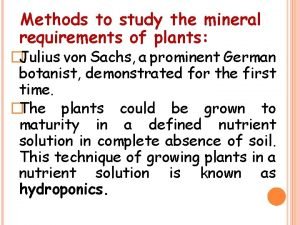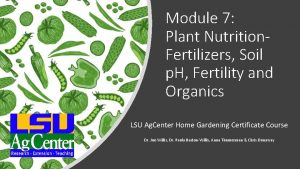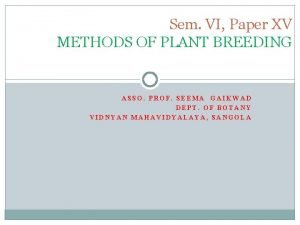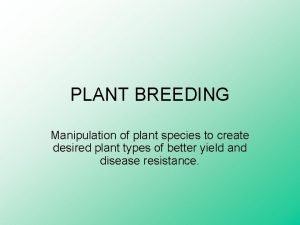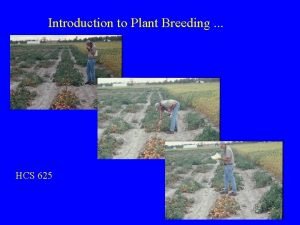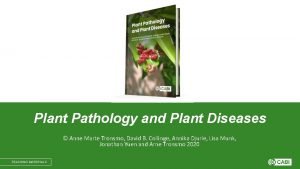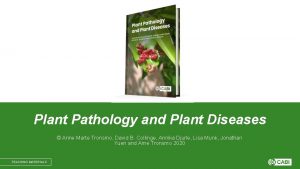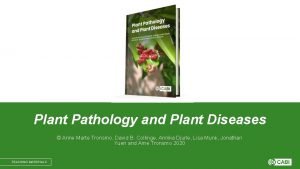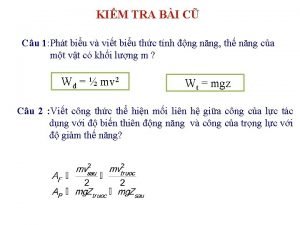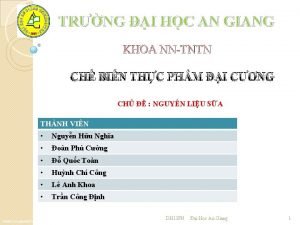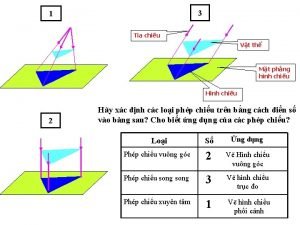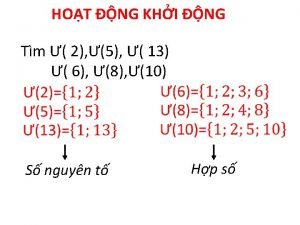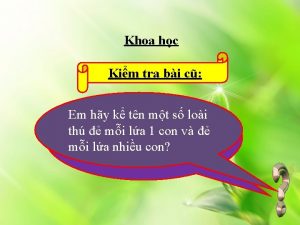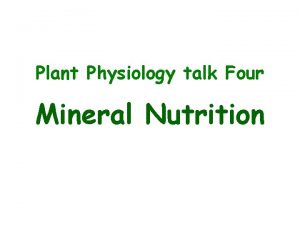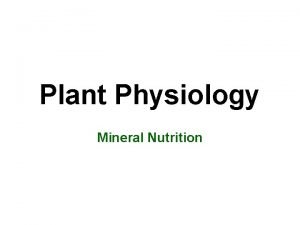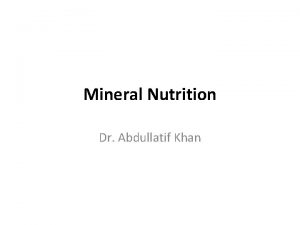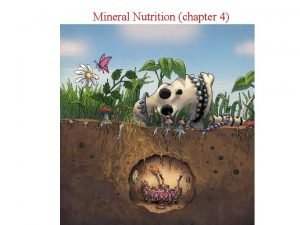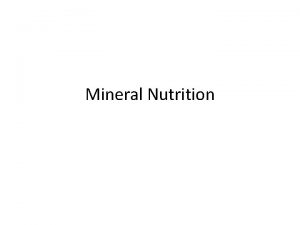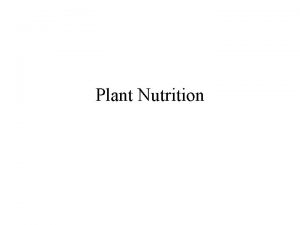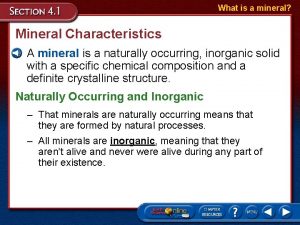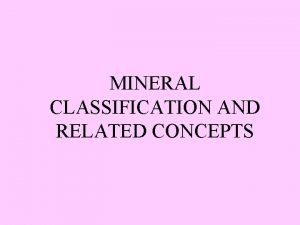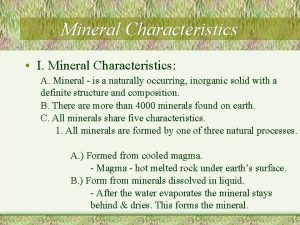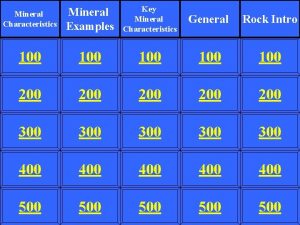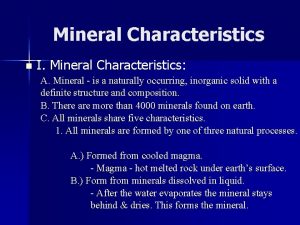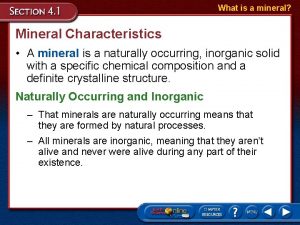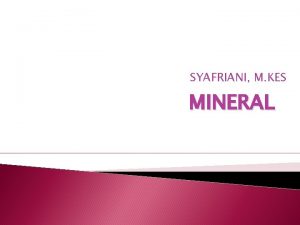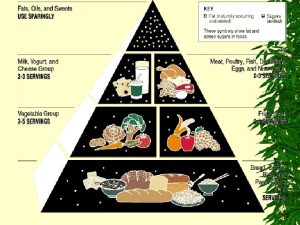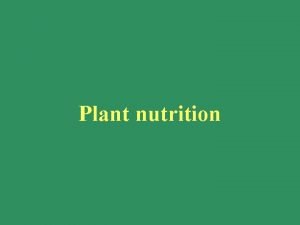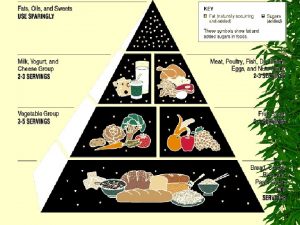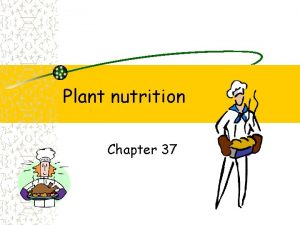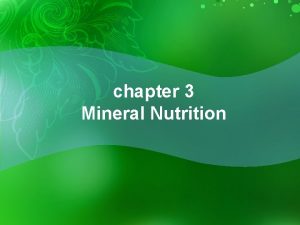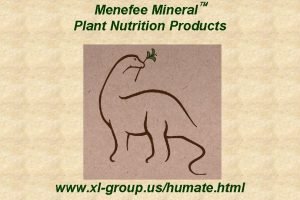Plant Mineral Nutrition Mineral Nutrition The study of


















































- Slides: 50

Plant Mineral Nutrition

Mineral Nutrition • The study of how plants obtain and use mineral nutrients is called plant mineral nutrition.

Importance of mineral nutrition • Green plants are autotrophic i. e. can synthesize their organic food from inorganic source • Animals are heterotrophic i. e. can not synthesize their organic food from inorganic source and depend directly or indirectly on plants for their food. • All plants require basic constituents/components for synthesis of food and functioning of metabolism. • Plants essentially require inorganic nutrients e. g. carbon, hydrogen, oxygen, nitrogen, phosphorus, potassium, sulphur, iron, manganese etc.

Essential and beneficial elements • Scientists have determined the whole profile of elements in plants • More than 60 elements are required for plant growth but all are not essentially required • Out of 60, 22 elements are essentially required


Essential elements • i) An element without which a plant cannot complete its life cycle; ii) Must not be replaceable by another element; iii) Must be directly involved in plant metabolism (Arnon and Stout, 1939). • An element which has a clear physiological role (Epstein, 1999). • If an element is deficient in a plant, specific deficiency symptoms will occur in plant.

Beneficial elements • Those elements when they are present, they stimulate the growth of plants but they are not essentially required for plant growth. • Plant growth will be better in the presence of beneficial elements. • Beneficial elements are 5 in number i. e. Na, Ni, Se, and Co (In some plants some of these elements act as essential elements)

Beneficial elements as essential elements • Sodium: there are 3 indicators of Na i) Kochia indica ii) Suaeda iii) Salsola • Nickel: Ni is essential in some plants e. g. in Jack bean (this plant cannot complete life cycle without Ni) • Silicon: Si is essential in some monocots e. g. grasses. In these plants Si is deposited around cell wall so they are more resistant to environmental stresses than the dicots. In rice 16. 4% is deposited in its cell wall.

Continuo-- • Selenium: It is essentially required for Astragalus, widely grown in California and is known as indicator of Se. • Cobalt: It is essential in Cyanobectria and Rhizobia.

• Antagonistic effects: When level or concentration of one element increases, it will lower down the concentration of other nutrient or effect of other nutrient e. g. phosphorus uptake is antagonistic by Ca 2+. • Nutrient efficient varieties: varieties which show better performance by absorbing low concentration of nutrients or good performance even in nutrient deficient soils.

Nutritional deficiency may due to one of the following reasons: 1. Non availability of particular element in soil 2. One nutrient is present in sufficient amount and cause the deficiency of other element “nutrient specific effect” 3. Due to certain viral induced diseases. These symptoms may b closely related to those caused by a particular nutrient deficiency

Study of nutrients’ deficiency • There are three well known methods to study nutrients deficiency 1) Hydroponics: The technique of growing plants with their roots emerged in nutrient solution without soil is called hydroponics or solution culture. 2) Nutrient film growth system: It is used to save excess amount of nutrient solution 3) Aeroponic growth system:

Hydroponics or solution culture Aeroponic growth system Nutrient film growth system

Classification of mineral nutrients • Based on concentration: nutrients are classified in plant tissues on the basis of how much nutrients are present in tissues e. g. in roots concentration of particular nutrient is high as compared to leaves. • i) Major or Macro-nutrients • ii) Minor or Micro-nutrients

Dry mass basis (Epstein, 1972, 1999) Major H C O N K Ca Mg P S Si ppm 60000 45000 15000 10000 5000 2000 1000 Minor Cl Fe B Mn Na Zn Cu Ni Mo ppm 100 20 50 10 20 6 0. 1

2. Source of availability • There are different sources e. g. air, soil • i) Atmosphere: Atmosphere contains C, H and O in the form of CO 2 and H 2 O • ii) Soil: Soil nutrients can be categorized into macro and micro nutrients. • When nutrients are present in more than 1000 ppm conc. , they are known as major • Micronutrients are those which are required in small amounts. If they are present in larger quantity, they will be toxic for plants

3. On the basis of physiological functions or biochemical reactions • On the basis of physiological functions, there are 4 groups • Group I: (N, S) • These elements are part of carbon compounds. This group has only two elements • i) nitrogen • ii) sulfur • Nitrogen: It is constituent of amino acids, nucleic acids, amides, proteins etc. • Its uptake from the soil is in the form of nitrate and ammonium (toxic for plants) • Essential for plant cell division, vital for plant growth • Directly involved in photosynthesis • Necessary component of vitamins • Aids in production and use of carbohydrates

• Sulfur: It is constituent of amino acids (cystein, methionine), proteins etc. It is taken up by the plants in form of sulfate. • Integral part of amino acids • Helps develop enzymes and vitamins • Promotes nodule formation on legumes • Aids in seed production • Necessary in chlorophyll formation (though it isn’t one of the constituents) • Group II: (P, Si, B) • Nutrients included in this group are important in energy storage or structural integrity. It contains 3 nutrients: • i) Phosphorus • ii) Silicon • iii) Boron • Phosphorus: main component of sugar phosphates, required for conversion of ADP to ATP, uptake form is phosphate (key role in ATP formation) • Involved in photosynthesis, respiration, energy storage and transfer, cell division, and enlargement • Promotes early root formation and growth • Improves quality of fruits, vegetables, and grains • Increases water-use efficiency

• Silicon: It is deposited as amorphous silica in cell wall, uptake form is monosilicic acid or monosilicate • Boron: Boron is taken up by plants primarily as H 3 BO 3 (boric acid) and H 2 BO 3 - (borate) • Essential formation of pollen grains and growth of pollen tubes • Essential for seed and cell wall formation • Promotes maturity • Necessary for sugar translocation. Boron plays an important role in the movement and metabolism of sugars in the plant and synthesis of plant hormones and nucleic acids.

Group III: (K, Ca, Mg, Cl, Mn, Na) It contains 6 elements and all are absorbed in ionic form. • Potassium: cofactor for more than 40 enzymes. Carbohydrate metabolism and the break down and translocation of starches • Increases photosynthesis • Increases water-use efficiency • Essential to protein synthesis • Important in fruit formation • Improves quality of seeds and fruit • Increases disease resistance • Calcium: important role in membrane stability. Utilized for Continuous cell division and formation • Involved in nitrogen metabolism • Reduces plant respiration • Aids translocation of photosynthates from leaves to fruiting organs

• • • • Magnesium: Key element of chlorophyll production Improves utilization and mobility of phosphorus Activator and component of many plant enzymes Increases iron utilization in plants Influences earliness and uniformity of maturity Chloride: Not much information about its functions Interferes with P uptake Enhances maturity of small grains on some soils Manganese: Functions as a part of certain enzyme systems Aids in chlorophyll synthesis Increases the availability of P and Ca

• • • • Sodium: acts as an essential elements for few species Group IV: (Fe, Cu, Zn, Ni, Mo) This group involves elements involved in redox reactions Iron: Promotes formation of chlorophyll Acts as an oxygen carrier Reactions involving cell division and growth, uptake is in the form of ferrous (Fe 2+) Copper: Catalyzes several plant processes Major function in photosynthesis Major function in reproductive stages Indirect role in chlorophyll production Increases sugar content whether it is absorbed as Cu or as chelate form. Zinc: Aids plant growth hormones and enzyme system Necessary for chlorophyll production Necessary for carbohydrate formation Necessary for starch formation Aids in seed formation, uptake the form of zinc ion

• Ni: uptake is also not clear • Mo: uptake form is molybdate (ammonium molybdate, sodium molybdate) • Required to form the enzyme "nitrate reductase" which reduces nitrates to ammonium in plant • Aids in the formation of legume nodules • Needed to convert inorganic phosphates to organic forms in the plant

Classification on the basis of mobility • Nutrients can be divided into two groups on the basis of mobility • Mobile nutrients: Those nutrients which can be translocated from one part to the other through phloem e. g. N, K, Mg, Mn, Cl, P, Na, Zn, Mo • Immobile nutrients: Those nutrients which can not be translocated from one part to the other through phloem. They can be transported through xylem e. g. Ca, S, Fe, B, Cu, Si

Deficiency symptoms • Reduction in growth: • Reduction in growth takes place due to specific reasons • Parts of plants that show symptoms: • Younger or older leaves • Stem • Roots • In case of deficiency of mobile nutrients symptoms will appear on older leaves while in case of immobile nutrients firstly on younger leaves

Deficiency symptoms based on physiological functions • Nitrogen: • Chlorosis: yellowing of leaves due to lack of chlorophyll. Symptoms will first appear on older leaves • Necrosis: necrotic spots will appear and destroy the tissues • Woody and cylindrical stem: Stem will appear woody and cylindrical because N is involved in N metabolism of carbohydrate. Due to deficiency of N these carbohydrates are not being used and stored in stem that’s why herbaceous plants sometimes show woody appearance • Pinkish appearance of leaves: due to excessive accumulation of anthocyanins because carbohydrates are not being utilized in N metabolism, N is used in accumulation of anthocyanins which give pinkish color to leaves.

• Sulfur • Deficiency symptoms are just like N because both are constituent of amino acids • Chlorosis: arises on the younger leaves because S is immobile • Retardation of cell division: suppression of fruit formation • Phosphorus: • mobile element so symptoms will first appear on old leaves • Stunted growth of young parts and dark green coloration of leaves (chlorophyll per unit area increases) • Necrosis • Production of cylindrical stem: Important physiological function such as photosynthesis, respiration are adversely affected due to shortage of P. All these processes depend upon NADPH, ATPs etc all of which contain P

• Silicon • Plants become susceptible to lodging: Si is constituent of cell wall. It gives strength to the cell and when there is deficiency of Si, plant will fall. • Plants become susceptible to fungal infections • Boron • Black necrosis of younger leaves: From base and those of terminal buds • Stiffness and brittleness of stem: stiff means hard and brittle means easily breakable • Loss of apical dominance: causes more branching of the plant • Inhibit cell division • Fruits become fleshy and tubers may show necrosis and breakdown of internal tissues • Immobile and symptoms first appear on older leaves

• Potassium • Marginal chlorosis/mottled: This marginal chlorosis later on develops into necrotic spots at the leaf tips, at the margins and between the veins because of the mobility of K within the plant. The symptoms initially appear on mature or older leaves • Leaves may be curled • Stem may be slender or weak with short internodes • Roots of K deficient plant may be susceptible to fungi which results in lodging of the plant • Calcium • Necrosis of young meristematic region i. e. tips of roots, stem or leaves where cell division or wall formation is high • Chlorosis and backward hooking of leaves • Roots appear brownish, short and highly branched • Plants may be severely stunted if meristematic regions die prematurely

• Magnesium • Chlorosis between leaves veins: As Mg is a part of chlorophyll so due to its deficiency there will be no photosynthesis in older leaves. Due to extensive deficiency whole leaf may become yellow or white • Premature abscission of leaf • Chloride • Wilting of leaf tips • General leaf chlorosis or necrosis • Bronzing of leaves • Roots may appear stunted and thickened near the tips • Manganese • Interveinal chlorosis with small necrotic spots. Mn is mobile so initial deficiency will be on older leaves • Also occur on younger leaves depending on plant species

• Sodium • Chlorosis or necrosis of leaves • In some plants there is failure to form flowers particularly in those where Na has an essential role • Iron • General chlorosis of young leaves due to immobility • In case of prolong deficiency, veins may also become chlorotic causing more leaves to turn white • Zinc • Reduces internodal growth and plants show rosette habit (little leaves) due to close origin of leaves • Small and distorted leaves • Chlorotic leaves or development of white necrotic spots because Zn is required for chlorophyll biosynthesis

• Copper • Production of dark green leaves containing necrotic spots firstly on young leaves • Twisting of leaves • Under permanent or extreme deficiency there is premature abscission of leaves • Nickel • Marginal chlorosis • Premature senescence • Cupped leaves (mouse ear) • Ni is part of urease enzyme in case of Ni deficiency, urease enzyme will not be there resulting in accumulation of urea that will cause leaf necrosis • Molybdenum • Co-factor nitrate reductase • Chlorosis between the veins and necrosis of older leaves • In some plants, the leaves may be twisted initially and die later on • No flower formation or there is premature flower abscission

Control measures • Fertilizers • To reduce or overcome nutrient deficiency, fertilizers are used and can be applied as foliar application or soil application

Control measures (fertilizer application) Soil application Foliar application Macronutrients Fertilizers Inorganic fertilizers Organic fertilizers (humus) Straight fertilizers (N/P/K) Micronutrients Compound fertilizers (mixed)

Application of fertilizers • When soil is deficient to nutrient, we add a particular nutrient. • Analyze the soil and measure its nutrient contents • If there is deficiency of a particular nutrient, add a particular fertilizer • Fertilizer application types • i) Soil application • ii) Foliar application

Soil application • These fertilizers are applied in the soil • These include inorganic or organic fertilizers • Most of the time macro or micro-nutrients are added in soil • NPK fertilizers are macro nutrients • Based on the type of fertilizers, we categorize them as • a) Straight fertilizers • b) Compound fertilizers

a) Straight fertilizers • Those fertilizers which contain only one type of nutrients are known as straight fertilizers e. g. N, K, or P • Super phosphate (to ameliorate P deficiency) • Ammonium nitrate (N) • Muriate of K (K) b) Compound fertilizers Those fertilizers which have two or more than two nutrients in a specific ratio e. g. if a fertilizer contains NPK then the ration will be 10, 14, 10 (N, P 2 O 5, K 2 O)

Micronutrients • No need to add • Some time deficiency due to agricultural practices • Plants require micronutrients in very low amount (mostly use their concentration in micrograms) • High amount will be toxic for plant growth • Some plants require high quantity of micronutrients e. g. rice requires high amount of Zn for better growth so we use Zn. SO 4

Organic fertilizers • These are natural i. e. when leaves become dead, they also become source of nutrients because they have macro and micronutrients • Adequate amount of organic fertilizer has better effect on plant growth as compared to inorganic fertilizer • Organic matter decomposes – mineralization • Mineralization depends upon many factors e. g. temperature, water, availability of oxygen, presence of micro-organisms, their types and number

Foliar application • Immediate remedy to recover deficiency • If plants has been damaged seriously, nutrients can be applied through leaves • Nutrients in solution form are applied as foliar spray on leaves and absorbed by leaves • Certain conditions are required for absorbance through leaves like use of surfactants • Surfactants – these are reagents which reduce the surface tension for maximum absorption. Among these common are tween 80 (organic), tween 20 etc. • Surfactants cause the breakdown of cutin on the surface of leaves. Both cutin and waxes are hydrophobic in nature and when this cuticle layer breaks, hydrophobic property reduces and absorptions occurs through epidermal cells •

Continue--- • Stomata do not absorb foliarly applied solutions because morphology of guard cells is in such a way that outward flow of water is easy but inward is not • Effect of surfactant is not permanent • Epidermal cells have genes which are involved in continuous synthesis of cutin and waxes • Epidermal layer is even broken down just by touching the leaf surface • So synthesis of cutin or waxes is continuous process

Exogenous application Application through one of the following way 1) Rooting medium 2) Pre-sowing seed treatment 3) Foliar application Also known as shot-gun approach and its effect is effective only for one generation while for next generation again application is required

Root mycorrhizae • Mycorrhizae – a Greek word for “fungus and roots” • Roots make an association with mycorrhizal fungi to modify absorption nutrients • 83% of dicotyledonous and 79% monocotyledonous plants and all gymnosperms forms mycorrhizal association • Plants from families Brassicaceae or Cruciferae (cabbage family), Chenopodiaceae (spinach family), Proteaceae (macademia nuts) and aquatic plants rarely have mycorrhizae • Also absent from roots in very dry, saline or flooded soils or where soil fertility is extreme i. e. high or low

Mycorrhizal fungi • Composed of fine tubular filaments called as hyphae which join to form fungal body called mycelium • There are two major classes of mycorrhizal fungi • 1. Ectotrophic mycorrhizae • 2. Endotrophic mycorrhizae (vesiculararbuscular mycorrhizae)

Ectotrophic mycorrhizae • These form a thick sheath or mantle around the roots of plants • Some mycelium penetrates between the cortical cells • Cortical cells are not penetrated by the hyphae but are surrounded by the network of hyphae called “Hartig net” • Increase the absorption capacity of roots particularly phosphorus • Usually found in trees, woody angiosperms, gymnosperms

Vesicular-arbuscular mycorrhizae • They do not form compact mantle around the roots and form less dense arrangement • Extend outward in the soil • About 10% of weight of root • Penetrate in individual cells of cortex forming two types of structures • a) oval structures (vesicles) • b) branched structures (arbuscules) • Hence, the term vesicular-arbuscular mycorrhizae is used • Found in herbaceous plants • Facilitate absroption of P and trace elements like Zn, Cu • Plants have these mycorrhizae absorb 4 times higher P in their roots as compared to non-assoiciated plants

Ion traffic into roots • Membrane carriers, channels and pumps are used to facilitate the transport of ions • Transport proteins have two major classes • 1) carrier proteins • 2) channel proteins • Carrier proteins (carriers, transporters, porters) bind to particular solute to be trasnported • Binding makes conformational changes in carrier protein, which delivers the solute to other side • After release of solute, protein again reverts to its original conformation and ready to pick up another solute

Channel proteins • Channel proteins form a charged-lined, waterfilled channel that extends across the membrane • Diffusion through channel is dependent hydrated size of ion because associated water molecule must diffuse along with ion • The number of ion channels discovered in plants is increasing • Currently there is solid evidence for K, Cl and Ca channels • Channel proteins are frequently gated i. e open or closed


Electrogenic pumps • • Involved in active transport of ions Against the gradient Tightly coupled with metabolic energy An important characteristic of pumps is that they are reversible • ATPase-proton pump
 Mineral nutrition in plants ppt
Mineral nutrition in plants ppt Mineral nutrition in plants ppt
Mineral nutrition in plants ppt Ginto yamang mineral
Ginto yamang mineral Dr nutrition
Dr nutrition Objective of plant breeding
Objective of plant breeding Plant introduction in plant breeding
Plant introduction in plant breeding Plant introduction in plant breeding
Plant introduction in plant breeding Tronsmo plant pathology and plant diseases download
Tronsmo plant pathology and plant diseases download Tronsmo plant pathology and plant diseases download
Tronsmo plant pathology and plant diseases download Tronsmo plant pathology and plant diseases download
Tronsmo plant pathology and plant diseases download Cyq qualifications
Cyq qualifications Hình ảnh bộ gõ cơ thể búng tay
Hình ảnh bộ gõ cơ thể búng tay Slidetodoc
Slidetodoc Bổ thể
Bổ thể Tỉ lệ cơ thể trẻ em
Tỉ lệ cơ thể trẻ em Gấu đi như thế nào
Gấu đi như thế nào Tư thế worms-breton
Tư thế worms-breton Chúa sống lại
Chúa sống lại Môn thể thao bắt đầu bằng từ đua
Môn thể thao bắt đầu bằng từ đua Thế nào là hệ số cao nhất
Thế nào là hệ số cao nhất Các châu lục và đại dương trên thế giới
Các châu lục và đại dương trên thế giới Công của trọng lực
Công của trọng lực Trời xanh đây là của chúng ta thể thơ
Trời xanh đây là của chúng ta thể thơ Mật thư tọa độ 5x5
Mật thư tọa độ 5x5 101012 bằng
101012 bằng Phản ứng thế ankan
Phản ứng thế ankan Các châu lục và đại dương trên thế giới
Các châu lục và đại dương trên thế giới Thể thơ truyền thống
Thể thơ truyền thống Quá trình desamine hóa có thể tạo ra
Quá trình desamine hóa có thể tạo ra Một số thể thơ truyền thống
Một số thể thơ truyền thống Cái miệng nó xinh thế chỉ nói điều hay thôi
Cái miệng nó xinh thế chỉ nói điều hay thôi Vẽ hình chiếu vuông góc của vật thể sau
Vẽ hình chiếu vuông góc của vật thể sau Nguyên nhân của sự mỏi cơ sinh 8
Nguyên nhân của sự mỏi cơ sinh 8 đặc điểm cơ thể của người tối cổ
đặc điểm cơ thể của người tối cổ Thế nào là giọng cùng tên? *
Thế nào là giọng cùng tên? * Vẽ hình chiếu đứng bằng cạnh của vật thể
Vẽ hình chiếu đứng bằng cạnh của vật thể Vẽ hình chiếu vuông góc của vật thể sau
Vẽ hình chiếu vuông góc của vật thể sau Thẻ vin
Thẻ vin đại từ thay thế
đại từ thay thế điện thế nghỉ
điện thế nghỉ Tư thế ngồi viết
Tư thế ngồi viết Diễn thế sinh thái là
Diễn thế sinh thái là Dạng đột biến một nhiễm là
Dạng đột biến một nhiễm là Số nguyên tố là gì
Số nguyên tố là gì Tư thế ngồi viết
Tư thế ngồi viết Lời thề hippocrates
Lời thề hippocrates Thiếu nhi thế giới liên hoan
Thiếu nhi thế giới liên hoan ưu thế lai là gì
ưu thế lai là gì Hổ đẻ mỗi lứa mấy con
Hổ đẻ mỗi lứa mấy con Khi nào hổ con có thể sống độc lập
Khi nào hổ con có thể sống độc lập Sơ đồ cơ thể người
Sơ đồ cơ thể người

